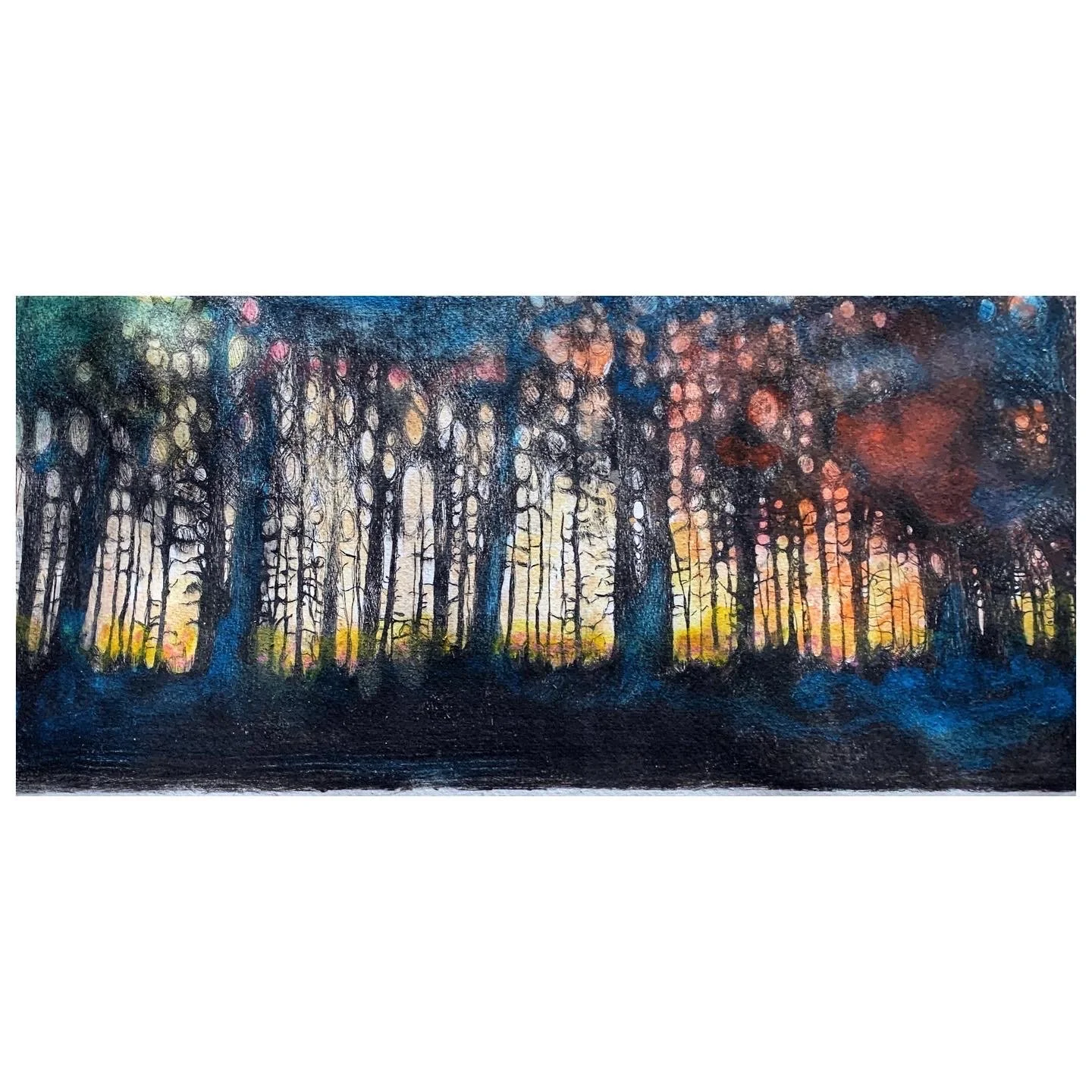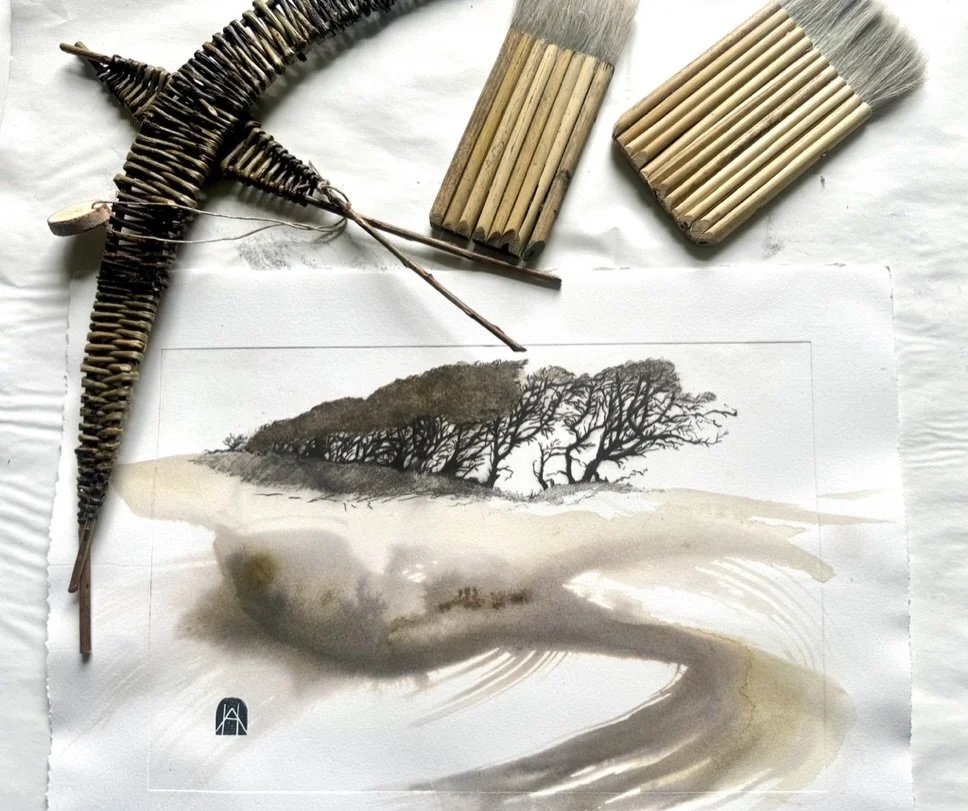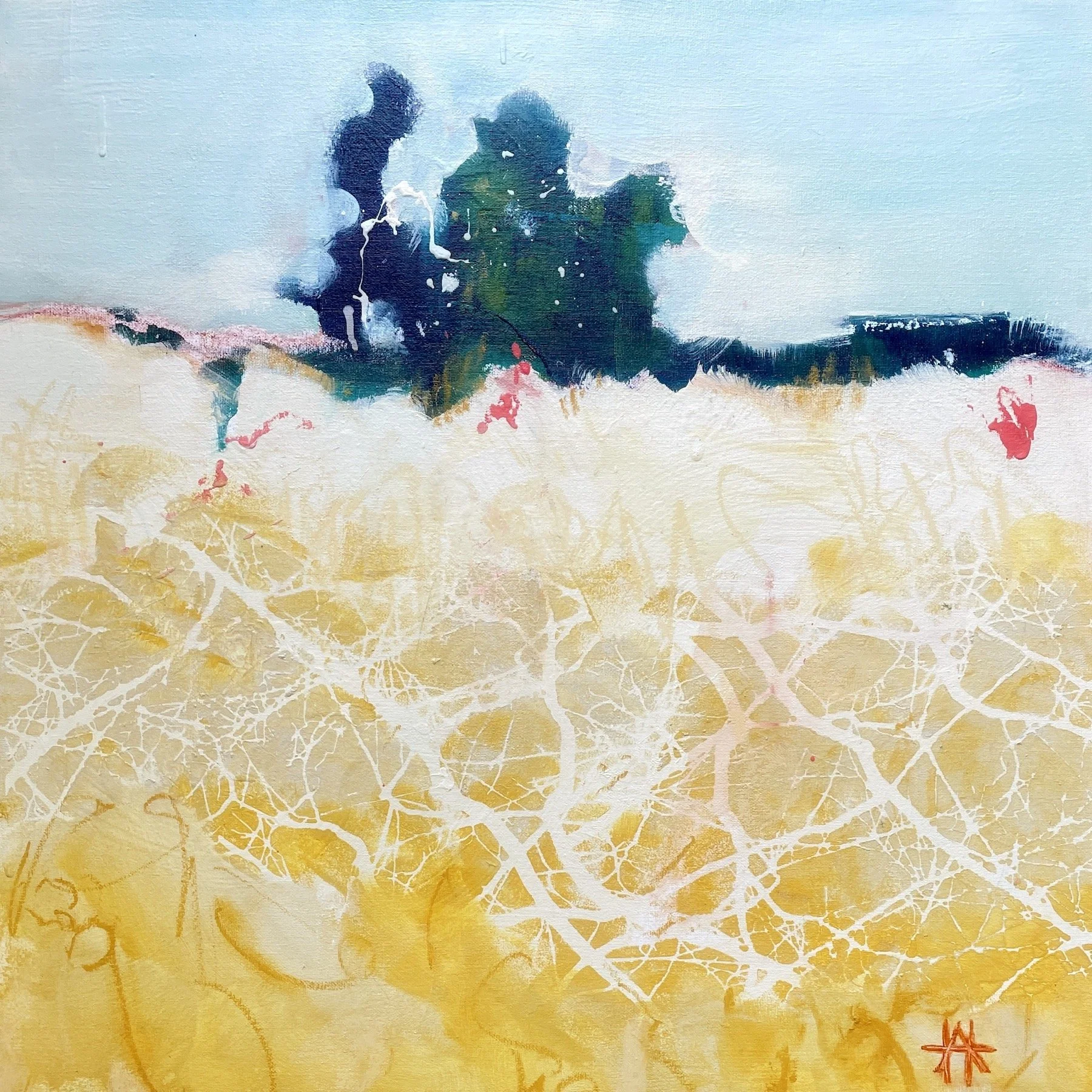
Tree songs
“To have you listen at all, it’s necessary to talk about trees…”
Adrienne Rich (1929-2012)
A video sharing the story behind “Tree songs” so far…. (9mins)
Snippets of illustrated memoir and nature writing from recent months. I have many ideas and notes, ripe for development to progress this project themed around tree species:
A gang of kids from the estate are hacking at a rowan sapling with a kitchen fork and pulling at one of its slender branches.
I’m on my daily commute, near Woolwich Dockyard train station – walking an unremarkable greater London pavement, polka-dotted with trodden-down chewing gum. This is two decades ago, before the Elizabeth line, the shopping outlets and penthouse suites.
Somehow I ended up living here, in a forgotten post-industrial landscape, mostly social housing or Victorian terraces, with concrete high rises and the gaudy Corbusian barrier across the Thames adding a surprising landmark (or river mark?), a sulking reminder that quayside southeast London is no Sydney Harbour. And it’s a long way from the Welsh borders of my childhood too. Here trees mostly grow from railway banks (buddleia) or diminishing gardens (fruit and bay). More stately species like poplars are hastily tarmac’ed around as if they’d erupted rebelliously after the developers had packed up and fled the scene.
There are plenty of TPOs in the area but not much in the way of new tree planting. The sapling near the station is a small gesture towards public health, a nod to the natural world in an otherwise pretty barren urbanscape. There’s hope in silver bark and autumnal red berries, which make me think of prayer flags.
As I spot the kids, four of them around ten years old, I feel heat rising in my face. Overcoming the tightening in my throat, the sound of my own voice emerges, raised but oddly squeaky, “Stop!” They look up, ready for combat but also surprised. I’m a bit shocked myself. “It’s growing.” I say, “It’s a living thing. What’re you doing?!”
Their expressions are blank. They’re considering their options, looking to each other. Bemused. They seem to have no idea. The consensus after a heart beat, not necessarily a thought gap, is to turn their backs on me and walk away. I feel instantly sorry about not being more positive or interactive, an opportunity lost, but also I’m relieved for the tree. And myself.
Perhaps there was disproportionate emotion as I made my way to work all those years ago, the injured tree in my mind’s eye, held in my heart. Whatever the scale of it, I noticed how strongly I felt. So saddened, troubled even. And that concern – a sense of loss and of divorce between children and nature – has stayed with me. A canker, or a form of grief.
Those children – possibly most of our children – have not been equipped to appreciate the sanctity of the natural world in all its diversity. But I too had become far-removed from nature. I was cast adrift, single, bogged down in a corporate booze set. Years and many miles away from a childhood of roaming, unhindered, so I could explore fields, play by streams and climb trees, with an innate and unstated sense that they were part of me and I them. More than that; I was nurtured by that childhood outdoors when nurturing was sorely needed.
I glimpsed it then and I see it clearly now: we need to talk about trees.
A tree of one’s own: sycamore
Before he made a life in southeast Asia, my father built an ugly house in England. He did this in the 1970s; in a Cheshire village, Kingsley, where the differences between the generations and classes were writ large in building styles, from labourers’ cottages, claustrophobic and dank before gentrification, to council housing bungalows and new-build estates.
In Kingsley, squat post-war semis still march up the hill, called The Hurst, to the Methodist Chapel with its arched windows, raised like indignant eyebrows, gazing down at the shocking sinners below. There are also one or two imposing Victorian houses, and the pub from the same era remains open, with its red-brick, mock Tudor facade. Then there’s the new builds, Barratt homes, mainly. The type that featured as a backdrop for Alan Bleasdale’s Boys from the Blackstuff.
But my dad built something different. A house for the nouveau riche, a contemporary one-off, which he called Hilltop. He designed it and helped with the construction. Later, it was diagnosed with sinking foundations, among other ailments, and it took years to sell when my mum was set to remarry and relocate to her Welsh childhood town.
The oddball Hilltop was an impractical, angular take on modernity. It included lots of glazing, either as wide oblongs, strangely high in the wall above eye-level, or tall, narrow factory-style windows rising up from ground level, even though the views were of nothing much but fences.
Central to the design was a two-storey atrium-style living space with a vaulted ceiling. The house was impossible to heat with a piss-poor oil-fed vector system that wafted out minimal warmth through a series of grills incorporated into the exposed-brick interior walls. Minimal style, minimal comfort. And just when there was an oil crisis and high inflation too. The small bedrooms had high-up, wide slit-shaped windows, like those in a wildlife hide. These were ideal for my brothers who stood on their beds, still wearing their boots, and took aim with a rickety air rifle, having a pop at passing birds. They became quite handy with their rifle and pigeon pie was a meal my mother could fall back on as we often had very little money. (My absent father withheld cash as a punishment for his ex’s independence.) So in some ways my brothers’ potshots were valuable but they were also indiscriminate. I hated them for this, and worried about the starlings that roosted in the yew tree next door.
The building plot for our house must have been sliced away from the garden of one of the larger traditional houses clustered in the heart of the village, like Kingsley Hall. These had an enduring if faded grandeur in stark contrast to the pound-store modernity of Hilltop. I know because I spied on other homes from the dizzy heights of an outlaw sycamore tree, which had sprung up too close to the flat-roofed garage my dad built. This tree was my secret, I thought. A tree of my own. It was a doddle to climb, as all acer species tend to grow many low-hung branches. And very safe as maples also develop a deep root system. I certainly felt secure and held by my tree. And it was easily taller than the surrounding houses.
I was drawn to the cool, shaded seclusion in summer so hid there regularly and closely observed the flashes of red in the leaf stalks and the acid-green helicopter seed pods that fell so elegantly to the ground below. I enjoyed watching their free fall and plucked my fair share from the mother tree. They are an ingenious design: their spinning motion is a balancing act. The seedhead (achene) is heavier than the wings, but the broad and light form of the winged casing catches the air. Gravity directs the aerodynamic seed to the earth while the wings spin around the central weight, ready to catch a breeze for wider dispersal. This was physics in action, I later learned.
A non-native, the sycamore was introduced to the British Isles from France in the middle ages. It’s a fast grower and provides ample leaf coverage, traditionally shading farm houses around the nation. The species is relatively resilient to high temperatures and low, and can deal with pollution and even sea spray. Many people seem to think it’s a problem tree, a pest because it seeds itself so easily and grows fast. But the sycamore is strong and will serve us well through years of climate change and damage to the environment. For me, it symbolises shelter, retreat and a place of learning through observation.
It’s also popular for making love spoons in Wales because it stays smooth after scrubbing, and doesn’t stain cloth. I have two such spoons in my art studio. They were made by sisters in grandmother’s family; the year 1829 is carved into them so the aunts were probably three generations older than her. The spoons are exquisite in their amateur style. One is cumbersomely broad handled, and engraved with two ducks (giving a good impression of being seagulls). In pursuit, an engraved fox with spindle legs and a fulsome tail. Also, where the clumsy handle meets the scoop of the spoon, there’s an engraving of a sapling or plant form. The other is a little more sophisticated: the body of the handle has been hollowed out to make a small cage structure in the light maple wood. Above it, a heart-shaped hole and then an engraving of hearts either end of the cage. A series of controlled tool marks make a delicate pattern down the bars of the cage, like edging on a seashell. And the wood is polished and varnished, tinting the spoon with a patina of treacle and syrup hues.
Sycamore timber is still used for finely grained pieces of furniture, and is valued for making violins and veneers. This is a wood of high art and culture. A timber of beauty and love.
“But we were never far from a tree. Trees were at the heart of our tribal culture. They were totems, landmarks, sources of raw materials. We did not know all their names but knew which provided the best wood for building and which for burning, which smelt the worst, which were the most thrilling to climb… Most of our dens were in trees of some sort – usually tucked between their trunks or perched a few feet up in the lower branches.” Richard Mabey, “Home Country”
From the sycamore den you could look over to the Barratt homes and bungalows of Highbank Road. This road ended in a playing field where I walked our rogue whippet-labrador, Honey. She had a bad reputation because she escaped the chaos of our home to create more chaos in the village. She raided bins, scattering the jetsam of domestic rubbish on pavements and driveways. Then, with a swollen trash-full belly, she visited the primary school playground, a magnet because of her love of children.
My family shared Honey’s bad reputation, led by my mother, the only divorced woman for miles around. She caused consternation among her peers when she came back from Singapore to set up house on her own. They somehow saw her as a threat to their marriages. This says more about their marriages than it does about my mum. Her two lost-boy sons were out of control too, and seen as a worrying influence among the village teens. And me? No idea what people thought of me. Perhaps I was just an onlooker, a spy in the branches.
On the other side of my leafy watch tower was an old man’s allotment plot full of purple sprouting broccoli that ran to seed, popping bright yellow blooms along the dark cinder path. And beyond was the large sandstone house with an old established garden, a goldfish pond and the big yew I mentioned, favoured by the starlings for roosting. There were also views to Marsha’s house. Marsha was the happy-go-lucky girlfriend of my second brother, with her enviable band of noisy siblings and two parents who had stayed together. I wanted to be Marsha, or at least Marsha’s little sister.
I shared my tree with other life. Lots of bugs and rows of their bright red eggs, stuck to the shady underside of the maple leaves like braille or a hidden code, and, of course, birds. My favourites being the starlings. I didn’t have the word for murmurations yet, but it was a thrill to feel close to this whistling, chattering slick-feathered gang who pulled off that swooping, group magic. They made an intense sight as they hung moving garlands in the sky, shape-shifting in and out of new geometries, elastic, electrifying and reactive. I really hated to think of them as targets for my brothers’ casual air gun brutality.
I guess I felt defensive of them. Actually, I didn’t want to be Marsha, I wanted to be one starling, secure among hundreds, part of some unfathomable dance which kept them safe from predators.
The Faraway Tree: plum
“And now, in the theatre of air,
They swing over buildings,
Dipping and rising;
They float like one stippled star
That opens,
Becomes for a moment fragmented,
Then closes again”
Mary Oliver ‘Starlings in Winter’
My passion for climbing trees was influenced – or perhaps just reinforced – by The Magic Faraway Tree books by Enid Blyton. Mostly a loner, I did have one little friend, dark eyed and quiet, called Susan. She wasn’t at my school but we were often brought together because we weren’t accepted by the estate kids. Perhaps we were “odd ones out”. There was an inverse parallel in our lives; Susan had been an unexpected child, born after 19 long years of hoping to conceive in a strong marriage. I was an unexpected child born after 9 possibly longer years of hoping not to conceive in a miserable marriage. Somehow, I defied the contraceptive copper coil.
Our parents were older than average, and we ourselves were perhaps a little different than our peers, like I say. Anyway, together we spent time in the lichen-covered plum tree in Susan’s garden, playing like Bessie and Fanny (who most certainly had not been updated to Beth and Frannie in the 1970s). We believed we could talk with Moon-face and Silky, and wished we could somehow make our own slippery-slip and slide magically to the ground.
The plum tree provided a bounty of unripened plums, which we collected and used as coins in our make-believe world. It was quite a small tree that tolerated scuffings from our brown Clarke’s school shoes. Their garden had a post-war feel about it, even three decades on. Susan’s dad had his allotment patch by the back door, mainly filled with brassicas and string beans. We watched as he battled with netting against a cloud of cabbage white butterflies that were present all summer-long. The cabbages were pock-marked wrecks by autumn, their skeletal leaves still sinuous because the veins (the “petiole” and “midrib” – such poetry in the language of biology) were too tough for caterpillar mandibles. All that remained was a sort of tatting, a delicate and random lacework, as full insult to the frustrated vegetable grower and father of one miracle child.
copyright: Helen Arthur 2024
Essays combining art history, creative journalling and nature writing. Three of 12 pieces published to my SubStack account Kitchen Table Creatives (links from description):
Peer testimonials and letters of support
“Helen Arthur is an exceptionally skilled and intelligent writer who considers her past with uncommon insight and writes in a very readable, engaging way. I know Helen to be efficient, reliable and very skilled as a person, who commits to the tasks she sets out to do.
I have known Helen since our time together on the MA in Creative Writing at the University of East Anglia in 1999-2000 where we were taught by WG Sebald and Lorna Sage, and where Helen stood out for her talent. In the intervening years Helen has also developed her talent for painting, while deepening her love of nature. She is now highly accomplished and I believe Helen is ready to launch her writing and art to a much larger audience.”
“I have admired not only Helen Arthur’s exquisite prints and paintings but also her attitude to her craft. She is a keen networker in our local creative community, taking part in and running mixed and solo art exhibitions, and she also provides educational opportunities for those who want to know more about printing and painting. I find her generous with her work and knowledge.”






